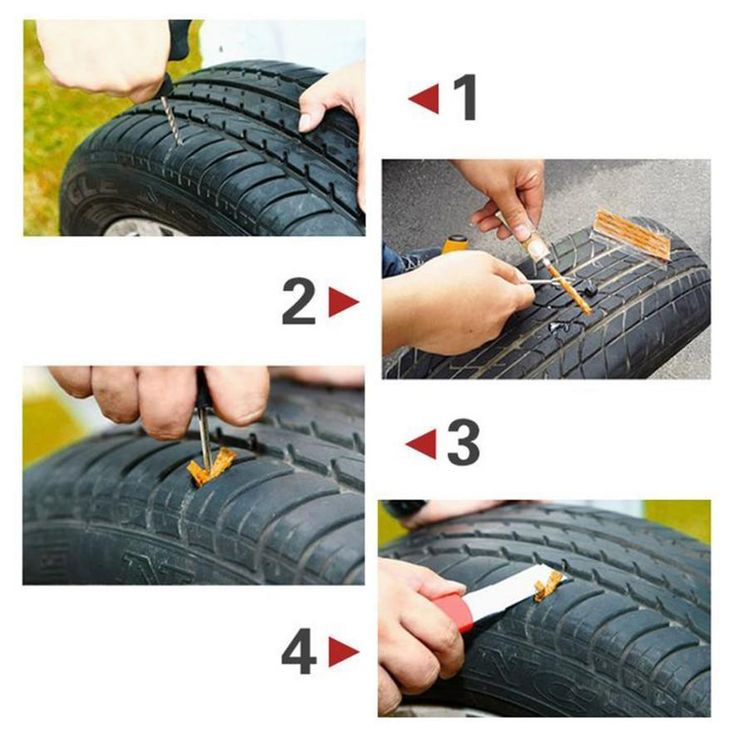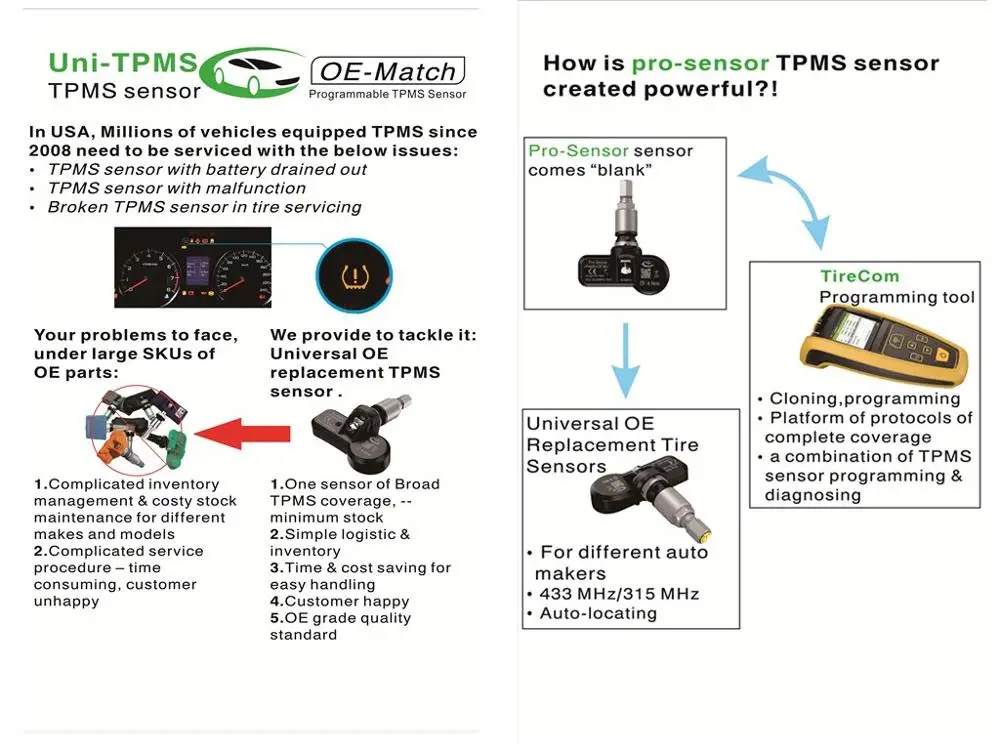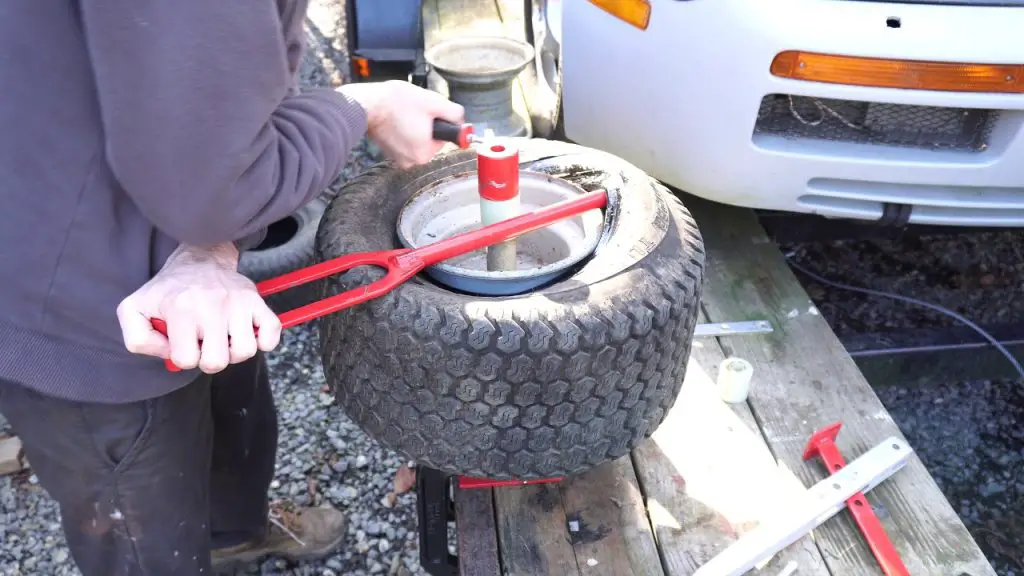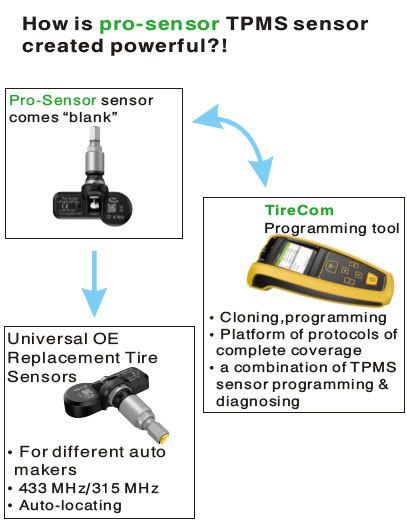Today’s vehicles come equipped with an ever-growing number of safety appliances, intended to keep motorists out of harm’s way. Many features and functions of this type are government mandated, and now come standard on virtually every vehicle manufactured.
Few of these safety features and functions are as prevalent as the Tire Pressure Monitoring System (TPMS), which was universally adopted by American automakers in 2007. This system alerts drivers when one or more of their vehicle’s tires have begun losing a noteworthy amount of air.
Though quite helpful in a sense, the modern TPMS system is not without its occasional flaws. With time, the components utilized by this system are subject to failure, thereby presenting a TPMS Fault, which must be addressed.
Read on to learn more about TPMS faults, as well as how to handle such issues, should they arise in the future.
Table of Contents
The modern Tire Pressure Monitoring System relies upon a set of sensors, which transmit critical data to a central management unit. This data reflects the approximate air pressure found within each tire. Each tire mounted on a vehicle equipped with a TPMS system has its own position-specific sensor, thereby allowing for efficient monitoring.
Unfortunately, these sensors are not intended for indefinite use, and typically require replacement at some point during the average vehicle’s service life.
This stems from the fact that each TPMS sensor is fitted with a miniature battery, which discharges over time. These batteries are non-replaceable, necessitating sensor replacement upon failure.
When a particular TPMS Sensor is no longer capable of transmitting data to the vehicle’s receiver, a TPMS Fault is stored, notifying the vehicle’s driver that monitoring has been effectively compromised. In order to alleviate this fault, the sensor in question must ultimately be replaced.
Many vehicles featuring first-generation Tire Pressure Monitoring Systems proved incapable of distinguishing between a faulty TPMS sensor, and a low PSI reading. In fact, only a single light was used in most cases to indicate either of these two issues.
In fact, only a single light was used in most cases to indicate either of these two issues.
For this reason, a “Sensor Fault” might be indicative of little more than a low tire in certain situations.
Read Also – Run Flat Tires vs Spare vs Repair Kit
The TPMS sensors are mounted to a tire’s valve stem, lying just to the inboard side of a tire’s bead. Due to the location of this sensor, special care must be taken when mounting or dismounting a tire, in order to prevent damage.
However, a few manufacturers have been known to mount a wheel’s TPMS sensor within a tire by alternative means. Many Ford vehicles feature TPMS sensors that are affixed to a metallic band, which clamps around the center circumference of a tire’s rim.
A Tire Pressure Sensor Fault can be caused by a number of underlying issues. Understanding the potential causes of this fault can prove helpful when attempting to remedy the problem at hand.
The following are several of the most common causes of a TPMS Fault.
One of the most common causes of a Tire Pressure Sensor Fault is the loss of battery charge within a TPMS Sensor itself. These sensors contain small batteries that discharge with time, thereby necessitating sensor replacement.
In certain cases, a tire’s TPMS Sensor can become damaged. This most often results from tire-to-curb impact or the use of incorrect tire mounting/dismounting procedures. More often than not, replacement of the affected sensor will be required.
While most vehicles now differentiate between a “Low Tire Warning”, and a “Tire Pressure Sensor Fault”, some earlier vehicles did not. For this reason, a TPMS Fault might indicate little more than low tire pressure.
In this case, the source of the affected tire’s air loss must be diagnosed.
You can drive with a TPMS Fault. However, doing so is not generally advised. This is due to the fact that in the presence of this fault, a vehicle’s TPMS is rendered ineffective. Though the system itself is still active, it registers little more than the presence of the fault in question.
However, doing so is not generally advised. This is due to the fact that in the presence of this fault, a vehicle’s TPMS is rendered ineffective. Though the system itself is still active, it registers little more than the presence of the fault in question.
Simply put, one is always advised to have a TPMS Fault corrected at the first available opportunity. This prevents a motorist from experiencing a low-tire condition at another wheel-end location, unbeknownst to their knowledge.
TPMS sensor replacement is now far less expensive than it once was, leaving little reason to ignore such issues.
At the very least, you should check each of your vehicle’s tires for proper inflation with the use of a manual gauge, before driving any further.
Certain vehicles register low PSI readings as “Tire Sensor Faults” making it necessary to manually establish whether or not each tire is adequately inflated. Driving on an underinflated tire can not only be dangerous but can also do severe damage to an otherwise repairable tire.
See Also – Michelin and GM Collaborate on Airless Tires
Most late model vehicles now feature a selectable TPMS display, which can be accessed via a vehicle’s instrument cluster. This display will provide feedback regarding each tire’s rate of inflation, and will also identify the sensor that is not providing feedback.
A non-responsive sensor will generally provide no value whatsoever when reviewing this prompt.
Outside of this menu, the location of a defective TPMS Sensor can also be identified through the use of the TPMS relearn tool. Most qualified tire shops and service centers have a tool of this type at their disposal, thereby simplifying the task of identifying a faulty sensor.
Theoretically, a TPMS Sensor can be replaced at home. However, doing so generally requires the use of several tools that the average person does not have at his or her disposal. This includes a tire machine and all appropriate toolage, as well as a TPMS relearn device, in many cases.
This includes a tire machine and all appropriate toolage, as well as a TPMS relearn device, in many cases.
Since a vehicle’s TPMS sensor is mounted to a tire’s valve stem in most cases, the affected tire must be deflated and partially dismounted to facilitate replacement. The use of improper equipment to accomplish this task can result in damage to the bead of a tire, thereby causing a significant leak.
Luckily, many automotive service centers are equipped to complete such repairs, for a nominal fee. Walmart, Discount Tire, Les Schwab, and Firestone are just a few of the major chain-type service centers which offer such repairs.
See Also – 4 Ways to Care For Your Tires (and Make Them Last Longer)
The exact cost of TPMS sensor replacement varies significantly, based on the year, make, and model of the vehicle that is to be repaired. While replacement sensors for some vehicles are easy to come by and economically priced, others are offered at a premium.
However, based on general averages, one can expect to pay between $70-$200 to have a single Tire Pressure Monitoring Sensor replaced and reprogrammed. Again, this number might be significantly higher, in the case of luxury vehicles, or those of a non-domestic make.
Assuming that your vehicle’s defective TPMS Sensor had been properly replaced, the continued illumination of a TPMS light indicates that this sensor has not yet been registered by the vehicle’s receiver. Most vehicles require a relearn procedure to be performed, in the event that a TPMS sensor has been replaced.
TPMS reset procedures differ from one model of vehicle to the next, though most centers around the use of a specialized relearn tool. Alternatively, some manufacturers require a vehicle to be driven at a designated speed for a set period of time, before a new sensor will be recognized.
If ever in doubt, return to the service center that installed your vehicle’s replacement TPMS sensor, and express your concerns. In most every case, this issue can be alleviated in minutes, getting you back on the road, free of unnecessary worry.
In most every case, this issue can be alleviated in minutes, getting you back on the road, free of unnecessary worry.
Steve Cooper
Owner at Auto Trends Magazine
Steve is a former ASE Certified Technician and holds a degree in automotive service technology from Weber State. When he's not searching for a 10mm socket in his garage, he enjoys a good BBQ with family and friends.
Latest posts by Steve Cooper (see all)
You can fix a tire sensor fault. Learn how to fix TPMS sensor below! All you have to do is get a TPMS scan tool to figure out which sensor(s) is bad. Then let all the air out of your tire(s) with a valve core remover tool. However, see below for a more detailed explanation.
*Don’t know how to tell if your TPMS Sensor is bad? Click here*
Advertisements
TPMS Relearn Tool
⭐️⭐️⭐️⭐️⭐️$15. $13.99 99
99
Buy Now
*Amazon Affiliate Products*
Tire pressure monitor sensor activation tool is simple and fast. It activates the individual TPMS sensor with the press of one button. It can easily be done within 1-2 minutes, saving you $20-$80. Much better and faster way to fix your sensors than going to the dealer.
PLEASE NOTE: This tool is for (Chevy / Buick / GMC / Opel / Cadillac etc, from 2006-2019, Cars, SUV, Pickup)
*Looking for a universal TPMS ReLearn Tool? Click here*
Use the right tools, the first time!
Tweet
Advertisements
Time needed: 10 minutes.
Learn how to fix TPMS sensor (replacement process)
A valve core is located inside your valve stem. Break the top bead of your tire then pull the old sensor out. Program your new sensor with your TPMS scan tool before you install the new sensor.
Remove the old sensor. If located on the opposite side of the valve stem, the sensor is mounted on a band that’s wrapped around the rim.
Program your new sensor with your TPMS scan tool before you install the new sensor.
Once the new sensor is in, go ahead and inflate your tire enough for the tire bead to seat. Then put the valve core back in your valve stem before all the air leaks out. Next, adjust your pressure to the tire sticker inside your driver door. Then get your tire scan tool out and retrain all your tire sensors.
Learn More About TPMS Tool
PLEASE NOTE: Most TPMS Sensors can be reached by breaking the top tire bead. However, some wheels make you take the tire off. These exceptions include: custom wheels, some reverse mount wheels, or band sensors.
*Also, it is a good idea to change valve stems when getting new tires if the valve stems are also the tire pressure sensors*
TPMS Band SensorWhat if replacing the sensors doesn’t work?
If replacing your TPMS sensors does not fix the problem then you most likely have a bad TPMS module. A TPMS module going bad is really rare when compared to how often TPMS sensors go bad. However, if you just had your tires replaced and they put new sensors in make sure you programed your sensors to your car with your TPMS scanner.
A TPMS module going bad is really rare when compared to how often TPMS sensors go bad. However, if you just had your tires replaced and they put new sensors in make sure you programed your sensors to your car with your TPMS scanner.
Can I replace just one TPMS sensor?
In short, you can just replace one TPMS Sensor. However, just make sure to retrain the new sensor with a TPMS Relearn Tool.
Updated requirements for the production of modern cars include a mandatory TPMS system. The direct type TPMS analyzes small, large and sudden changes in pressure. Device sensors are placed inside each tire and signal a problem by transmitting information to the on-board computer. As a result, a special indicator lights up on the dashboard. This device provides a lot of positive aspects. The system notifies the driver that the pressure in the tires of the car is reduced relative to the established norms.
Timely elimination of the problem allows:
Like many car parts, the TPMS system needs periodic qualified maintenance, which is available at the Shlepakov Tire Bureau.
What is included in our service package?
In the maintenance of tire pressure monitoring systems, our specialists are ready to provide you with the following services:
diagnostics of the TPMS system - using the most modern equipment allows you to solve any problem related to replacing sensors, setting up and restoring the functionality of the system. The year of manufacture, model and brand of car does not matter;
cloning or duplication of sensors - this service means the repair or replacement of a standard sensor by copying information from it and transferring it to a new original or universal sensor. As a result, the clones completely repeat the regular device and function immediately in the normal mode;
registration of tire pressure sensors - recently, on cars of Asian or American production, pressure monitoring systems are increasingly found that require registration of the sensor in the on-board computer for its normal operation. This service is available for all types of cars, any year of manufacture;
This service is available for all types of cars, any year of manufacture;
installation of aftermarket TPMS systems - if your vehicle manufacturer has not provided for the presence of a device that is important today, we will help you correct this defect. Our experts will help you choose a TPMS system, install and connect it, and set up its correct functioning.
If you want to keep up with technological progress or suspect a malfunction in the operation of the equipment, contact the professionals of the Shlepakov Tire Bureau, and we will solve the problem of any complexity.
Autel 315 MHz universal MX sensors with a metal stem are designed to monitor tire pressure and temperature. The device consists of an electronic measuring and control component, a battery and a transmitting antenna. The sensor is installed on each wheel instead of a regular valve, and the signals from it are transmitted by pulses at a certain frequency.
The Autel TPMS Universal Reprogrammable Sensor is used as the most affordable way to eliminate the need for costly original sensors (OEM sensors) on vehicles fitted with tire pressure monitoring systems.
Special Features:
98% coverage of all original sensors (OEM). Autel sensors allow you to create a full copy of the original sensor, released by manufacturers such as Schrader, Continental, Huf, TRW, etc.
100% compatible. Autel is a manufacturer of sensors and equipment for working with sensors, which allows you to have full compatibility of software, communication protocols with equipment installed on the car.
Ease of installation. The nipple with angle adjustment up to 35° and detachable from the main sensor makes it possible to simplify the process of installing the sensor on alloy wheels, thereby saving time on vehicle maintenance during seasonal peaks in demand (time = money).
Sensor serviceability. Support for wireless programming gives you the freedom to work with sensors and gives you the ability to work with sensors mounted on rims.
Support for wireless programming gives you the freedom to work with sensors and gives you the ability to work with sensors mounted on rims.
Sensor quality. All sensors are tested and certified to SAE standards.
Durability. The average service life of the sensor, depending on the operating conditions, is 5-7 years, which indicates the high quality of Autel sensors.
Warranty. The unique warranty for genuine Autel sensors purchased from Autel Russia is 2 years.
Low sensor weight. Allows you to minimize the number of weights installed on the rim when balancing the wheel after assembly.
Many drivers of modern cars may encounter a problem - the tire pressure sensor is on. What should be done in this case? How to acquire such a device if it is not provided in the factory configuration? We will talk about all this below.
Equal pressure in each of the four wheels for a comfortable and safe ride . If there is no desire to check this parameter manually, you can entrust this to electronics. Basically, this equipment is battery-powered, and the instrument panel, in case of any malfunction, when the pressure drops below the allowable one, turns on the control lamp. In order for the readings to be as accurate as possible, four devices are needed, while each tire pressure monitoring sensor has its own separate battery and transmits data to the control module.
Today there are two types of such devices: external tire pressure sensors and internal ones. If you have several cars, or you are fond of "off-road" on your favorite SUV, then the first option will be more suitable for you, since external devices are mounted directly on the nipple, and they can be quite easily rearranged from one rubber to another. The internal ones, which already belong to the new generation, are attached to the car disc instead of the mouthpiece. Such a tire pressure indicator sensor is lightweight, so there can be no problems with its installation, and if you wish, you can do it yourself.
The internal ones, which already belong to the new generation, are attached to the car disc instead of the mouthpiece. Such a tire pressure indicator sensor is lightweight, so there can be no problems with its installation, and if you wish, you can do it yourself.
The battery, located inside the sensor itself, is designed for a minimum of seven years of uninterrupted operation.
The installation of tire pressure sensors will take quite a bit of time, but, in this way, it will be possible to fully control the situation, because, as you know, a pressure difference of just a few tenths of a bar cannot be visually determined. But, as research shows, a difference of only 0.4 bar for the front and 0.6 for the rear wheels is critical, which means that your car is completely beyond your control and can behave quite unpredictably, especially in an emergency.
Mechanical damage is also quite common, such as a broken nipple, most often this is due to a road surface that is far from ideal. However, sometimes such a breakdown can also occur through the fault of the owner, for example, if he inaccurately unscrews the tire pressure indicator caps, etc. Naturally, it is quite easy to notice such malfunctions, only a visual inspection is enough.
What to do if the tire pressure sensor lights up, while the pressure is at the right level? As mentioned above, the device must be reset, for this you should turn off the engine, then, turning on the ignition, but without starting the engine, hold down the SET button and hold until the sound signal appears. Now you can safely start the engine and continue on your way. In case of mechanical damage, it is necessary to replace the broken element; they are quite easy to find on the shelves of specialized stores.